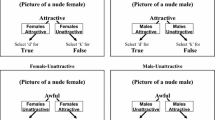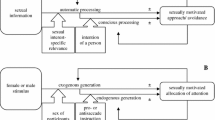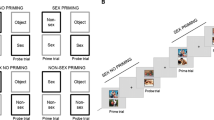Abstract
The purpose of this study was to investigate the use of a choice reaction time task, during which slides of sexually explicit and neutral stimuli were used as an interference task, to differentiate between groups of individuals on the basis of their sexual preference. Twenty subjects, in each of the four groups (heterosexual males, heterosexual females, homosexual males, and homosexual females), participated in this study. Sexual orientation was determined by self-report. Subjects were given a choice reaction time with interference task, followed by a recall incidental learning task. A significant higher-order interaction was found among gender, orientation, and stimulus type for all four groups. This interaction indicated a longer reaction time to slides depicting preferred sexual partners than to nonpreferred sexual partners or neutral scenes. These results indicate that sexual arousal does interfere with cognitive processing. A main effect for gender was found for the incidental learning task, with males having the fewest errors.
Similar content being viewed by others
References
Erickson, W. S., Luxenberg, M. G., Walbek, N. H., & Seely, R. K. (1987). Frequency of MMPI two-point code types among sex offenders.Journal of Consulting and Clinical Psychology, 55, 566–570.
Hall, G. C., Maiuro, R. D., Vitaliano, P. P., & Proctor, W. C. (1986). The utility of the MMPI with men who have sexually assaulted children.Journal of Consulting and Clinical Psychology, 56, 118–122.
Kinsey, A. C., Pomeroy, W. B., & Martin, C. E. (1948).Sexual behavior in the human male. Philadelphia: W. B. Saunders.
Masters, W. H., & Johnson, V. E. (1966).Human sexual response. Boston: Little, Brown.
McAnulty, R. D., Adams, H. E., & Andrew, M. (1989).Characteristics of individuals who deny the validity of child molestation accusations. Paper presented at the meeting of the Association for the Advancement of Behavior Therapy, Washington, DC, Nov.
Mehrabian, A. (1968). Inferences of attitude from posture, orientation, and distance of a communicator.Journal of Consulting and Clinical Psychology, 32, 298–308.
O'Donohue, W., & Letourneau, E. (1992). The psychometric properties of penile tumescence assessment of child molesters.Journal of Psychopathology and Behavioral Assessment, 14, 123–174.
Patterson, M. L. (1975). An arousal model of interpersonal intimacy.Psychological Review, 83, 235–245.
Rosen, R. C., & Beck, G. (1988).Patterns of sexual arousal: Psychophysiological processes and clinical applications. New York: Guilford.
Rosen, R. C., & Kopel, S. A. (1977). Penile plethysmography and biofeedback in the treatment of a transvestite-exhibitionist.Journal of Consulting and Clinical Psychology, 45, 908–916.
Singer, B. (1984). Conceptualizing sexual arousal and attraction.The Journal of Sex Research, 20, 230–240.
Author information
Authors and Affiliations
Rights and permissions
About this article
Cite this article
Wright, L.W., Adams, H.E. Assessment of sexual preference using a choice reaction time task. J Psychopathol Behav Assess 16, 221–231 (1994). https://doi.org/10.1007/BF02229209
Accepted:
Issue Date:
DOI: https://doi.org/10.1007/BF02229209




